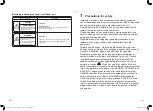
� 11 �
21-EN
22-EN
■
Refrigerant pipe length
Single
Model
Allowable pipe length (ft (m))
Height difference (Indoor-outdoor H) (ft (m))
Total length L
Indoor unit: Upper
Outdoor unit: Lower
SP122, SP182
164’1” (50)
98’5” (30)
98’5” (30)
Model
Pipe diameter
Number of bent portions
Liquid side
Gas side
SP122, SP182
Ø1/4” (6.4 mm)
Ø1/2” (12.7 mm)
10 or less
Figure of Single
Indoor unit
Outdoor unit
6
Vacuum
CAUTION
UNIT DAMAGE HAZARD
Failure to follow this caution may result in equipment
damage or improper operation.
Never use the system compressor as a vacuum pump.
Refrigerant tubes and indoor heat exchanger should
be evacuated using the recommended deep vacuum
method of 500 microns. The alternate triple evacuation
method may be used if the procedure outlined below is
followed. Always break a vacuum with dry nitrogen.
System vacuum and charge
Using Vacuum Pump
1. Completely tighten flare nuts A, B, C, D, connect
manifold gage charge hose to a charge port of the
low side service valve.
2. Connect charge hose to vacuum pump.
3. Fully open the low side of manifold gage.
4. Start vacuum pump.
5. Evacuate using either deep vacuum or triple
evacuation method.
6. After evacuation is complete, fully close the low side
of manifold gage and stop operation of vacuum
pump.
Service Valve
Manifold
Manifold Gage
Outdoor Unit
500 microns
Low side valve
High side valve
Vacuum pump
Packed valve at gas side
Charge port
(Valve core (Setting pin))
Indoor Unit
Service Valve
High Side
Refrigerant
Low Side
Charge hose
Charge hose
Deep Vacuum Method
The deep vacuum method requires a vacuum pump
capable of pulling a vacuum of 500 microns and a
vacuum gage capable of accurately measuring this
vacuum depth. The deep vacuum method is the most
positive way of assuring a system is free of air and
liquid water.
Triple Evacuation Method
The triple evacuation method should only be used
when vacuum pump is only capable of pumping down
to 28 in. of mercury vacuum and system does not
contain any liquid water.
Refer to “Triple Evacuation Method chart” and proceed
as follows:
1. Pump system down to 28 in. of mercury and allow
pump to continue operating for an additional 15
minutes.
2. Close service valves and shut off vacuum pump.
3. Connect a nitrogen cylinder and regulator to system
and open until system pressure is 2 psig.
4. Close service valve and allow system to stand for
1 hr. During this time, dry nitrogen will be able to
diffuse throughout the system absorbing moisture.
5. Repeat this procedure as indicated in the chart.
System will then be free of any cotaminants and
water vapor.
Deep Vacuum Graph
MICRONS
MINUTES
LEAK IN
SYSTEM
5000
4500
4000
3500
3000
2500
2000
1500
1000
500
0
1
2
3
4
5
6
7
VACUUM TIGHT
TOO WET
TIGHT DRY
SYSTEM
1131701101-00_S01_297x210_60p_S_p70_220426.indd 11
26/4/2565 11:41:10







































